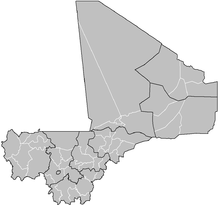Niafunké Cercle | |
|---|---|
 Location of the Cercle of Niafunké in Mali | |
| Country | |
| Region | Tombouctou Region |
| Admin HQ (Chef-lieu) | Niafunké |
| Area | |
| • Total | 12,000 km2 (5,000 sq mi) |
| Population (2009 census)[2] | |
| • Total | 184,285 |
| • Density | 15/km2 (40/sq mi) |
| Time zone | UTC+0 (GMT) |
Niafunké Cercle is an administrative subdivision of the Tombouctou Region of Mali. The administrative center (chef-lieu) is the town of Niafunké. In the 2009 census the cercle had a population of 184,285. The Niger River runs for 100 km through the cercle.[citation needed]
The cercle is subdivided into eight communes:[3][4]
References
[edit]- ^ Synthèsis des Plan de Securité Alimentaire des Commune du Cercle de 2006-2010 (PDF) (in French), Commissariat à la Sécurité Alimentaire, République du Mali, USAID-Mali, 2006, archived from the original (PDF) on 2012-04-29.
- ^ Resultats Provisoires RGPH 2009 (Région de Tombouctou) (PDF) (in French), République de Mali: Institut National de la Statistique
- ^ Loi N°99-035/ du 10 Aout 1999 Portant Création des Collectivités Territoriales de Cercles et de Régions (PDF) (in French), Ministère de l'Administration Territoriales et des Collectivités Locales, République du Mali, 1999, archived from the original (PDF) on 2012-03-09.
- ^ Communes de la Région de Tombouctou (PDF) (in French), Ministère de l’administration territoriale et des collectivités locales, République du Mali, archived from the original (PDF) on 2012-03-09.
15°55′N 3°50′W / 15.917°N 3.833°W


Well, that’s interesting to know that Psilotum nudum are known as whisk ferns. Psilotum nudum is the commoner species of the two. While the P. flaccidum is a rare species and is found in the tropical islands. Both the species are usually epiphytic in habit and grow upon tree ferns. These species may also be terrestrial and grow in humus or in the crevices of the rocks.
View the detailed Guide of Psilotum nudum: Detailed Study Of Psilotum Nudum (Whisk Fern), Classification, Anatomy, Reproduction